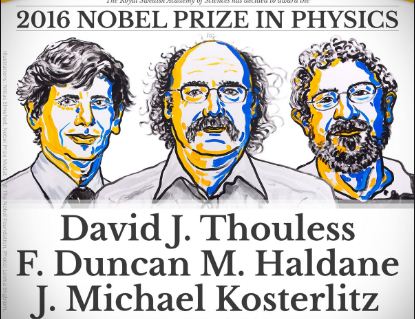The 2016 Nobel prize in physics is awarded to David Thouless, Duncan Haldane and Michael Kosterlitz for their work on exotic states of matter.
About Nobel Prize in Physics :
The Nobel Prize in Physics is a yearly award given by the Royal Swedish Academy of Sciences for those who conferred the most outstanding contributions for mankind in the field of physics.
- It is one of the five Nobel Prizes established by the will of Alfred Nobel in 1895 and awarded since 1901; the others being the Nobel Prize in Chemistry, Nobel Prize in Literature, Nobel Peace Prize, and Nobel Prize in Physiology or Medicine.
- The first Nobel Prize in Physics was awarded to a German physicist Wilhelm Röntgen in recognition of the extraordinary services he has rendered by the discovery of the remarkable rays.
- This award is administered by the Nobel Foundation and widely regarded as the most prestigious award that a scientist can receive in physics.
- It is presented in Stockholm at an annual ceremony on December 10, the anniversary of Nobel’s death. Through 2015, a total of 200 individuals have been awarded the prize.
- A maximum of three Nobel laureates and two different works may be selected for the Nobel Prize in Physics. Compared with other Nobel Prizes, the nomination and selection process for the prize in Physics is long and rigorous. This is a key reason why it has grown in importance over the years to become the most important prize in Physics.
About David James Thouless,
David James Thouless is a British condensed-matter physicist, Wolf Prize winner and laureate of the 2016 Nobel Prize for physics along with Duncan M. Haldane and J. Michael Kosterlitz for theoretical discoveries of topological phase transitions and topological phases of matter.
- Dr. Thouless, 82, explored the behavior of swirling vortexes in super fluids and other problems related to topological quantum numbers
- Thouless was a post doc at the University of California, Berkeley, and professor of mathematical physics at Birmingham University in the United Kingdom from 1965-1978 before becoming a professor of physics at the University of Washington in Seattle in 1980.

- He has made many theoretical contributions to the understanding of extended systems of atoms and electrons, and of nucleons. His work includes work on super conductivity phenomena, properties of nuclear matter, and excited collective motions within nuclei.
About Duncan Haldane :
Frederick Duncan Michael Haldane is a British physicist who is Eugene Higgins Professor of Physics at the physics department of Princeton University in the United States, and a Distinguished Visiting Research Chair at Perimeter Institute for Theoretical Physics. He shared the 2016 Nobel prize for physics with David J. Thouless and John Michael Kosterlitz.
- Haldane is known for a wide variety of fundamental contributions tocondensed matter physics including the theory of Luttinger liquids, the theory of one-dimensional Spin chains, the theory of Fractional Quantum Hall Effect, Exclusion Statistics, Entanglement Spectra and much more.
- He is currently developing a new geometric description of the fractional quantum Hall effect that introduces the “shape” of the “composite boson”, described by a “unimodular” (determinant 1) spatial metric-tensor field as the fundmamental collective degree of freedom of FQHE states.
- This new “Chern-Simons + quantum geometry” description is a replacement for the “Chern-Simons + Ginzburg-Landau” paradigm introduced c.1990. Unlike its predecessor, it provides a description of the FQHE collective mode that agrees with the Girvin-Macdonald-Platzman “single-mode approximation”.
About Michael Kosterlitz :
John Michael Kosterlitz is a professor of physics at Brown University and the son of biochemist Hans Kosterlitz. He was awarded the 2016 Nobel Prize in physics along with David Thouless and Duncan Haldane for work on condensed matter physics.
- After a few post doctoral positions, including stints at the University of Birmingham, collaborating with David Thouless, and at Cornell University.
- He was appointed to the faculty of the University of Birmingham in 1974, first as a lecturer and, later, as a reader. Since 1982, he has been professor of physics at Brown University. Kosterlitz is currently a visiting research fellow at Aalto University in Finland.
- Kosterlitz does research incondensed matter theory, one- and two-dimensional physics; in phase transitions: random systems, electron localization, and spin glasses; and in critical dynamics: melting and freezing.






